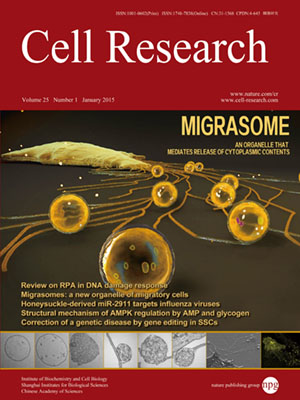
Volume 25, No 1, Jan 2015
ISSN: 1001-0602
EISSN: 1748-7838 2018
impact factor 17.848*
(Clarivate Analytics, 2019)
Volume 25 Issue 1, January 2015: 121-134 | Open Access
ORIGINAL ARTICLES
The molecular mechanism of SPOROCYTELESS/NOZZLE in controlling Arabidopsis ovule development
Baoye Wei1, Jinzhe Zhang1, Changxu Pang1, Hao Yu1, Dongshu Guo1, Hao Jiang1, Mingxin Ding1, Zhuoyao Chen1, Qing Tao1, Hongya Gu1,2, Li-Jia Qu1,2,3 and Genji Qin1
1State Key Laboratory of Protein and Plant Gene Research, College of Life Sciences, Peking University, Beijing 100871, China
2The National Plant Gene Research Center (Beijing), Beijing 100101, China
3Peking-Tsinghua Center for Life Sciences, Peking University, Beijing 100871, China
Correspondence: Genji Qin,(qingenji@pku.edu.cn)
Ovules are essential for plant reproduction and develop into seeds after fertilization. SPOROCYTELESS/NOZZLE (SPL/NZZ) has been known for more than 15 years as an essential factor for ovule development in Arabidopsis, but the biochemical nature of SPL function has remained unsolved. Here, we demonstrate that SPL functions as an adaptor-like transcriptional repressor. We show that SPL recruits TOPLESS/TOPLESS-RELATED (TPL/TPR) co-repressors to inhibit the CINCINNATA (CIN)-like TEOSINTE BRANCHED1/CYCLOIDEA/PCF (TCP) transcription factors. We reveal that SPL uses its EAR motif at the C-terminal end to recruit TPL/TPRs and its N-terminal part to bind and inhibit the TCPs. We demonstrate that either disruption of TPL/TPRs or overexpression of TCPs partially phenocopies the defects of megasporogenesis in spl. Moreover, disruption of TCPs causes phenotypes that resemble spl-D gain-of-function mutants. These results define the action mechanism for SPL, which along with TPL/TPRs controls ovule development by repressing the activities of key transcription factors. Our findings suggest that a similar gene repression strategy is employed by both plants and fungi to control sporogenesis.
10.1038/cr.2014.145
FULL TEXT | PDF
Browse 2378


